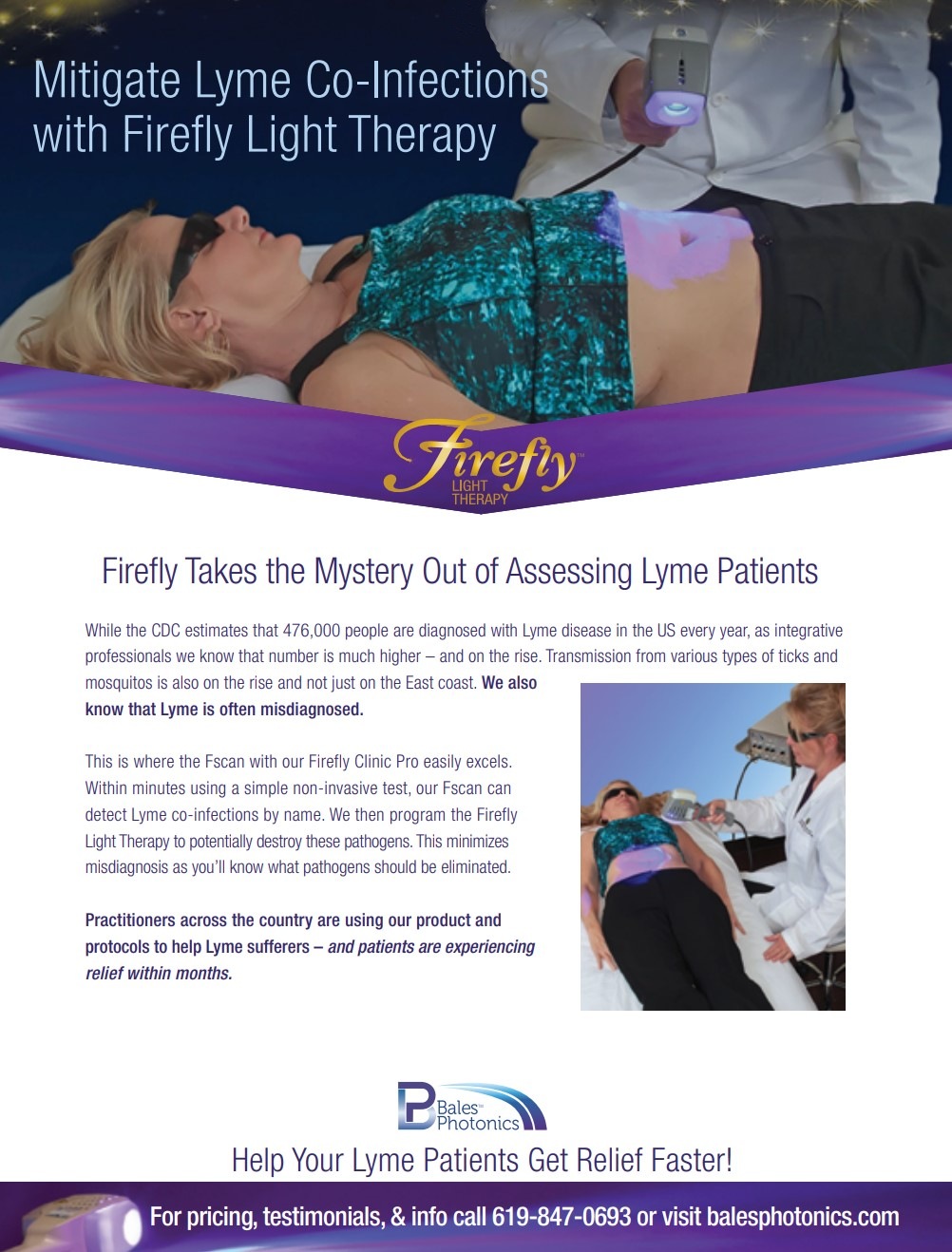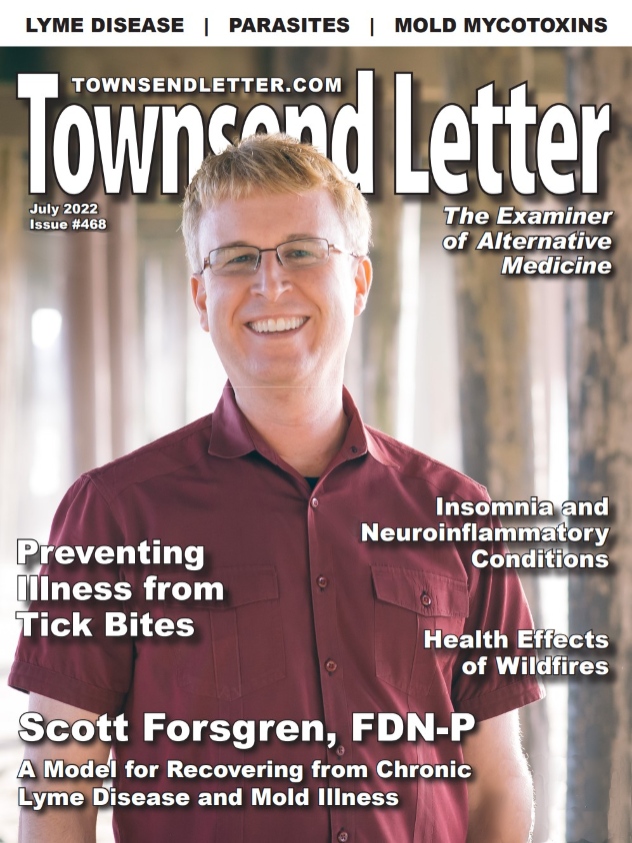….Article continues:
She wanted to treat some of her symptoms with supportive herbal and supplemental interventions first and wait for the test results. The results came back within days with multiple tick-borne infections, which took the mystery out and provided a framework for reviewing what is important to her, and what options we may have to proceed. She opted for a combination of pharmaceutical and non-pharmaceutical interventions, and we tracked her progress and symptoms with regular monitoring and lab work. This outlines the importance of considering that Lyme is not the only infection, symptoms may not present with what is considered “typical” (Bull’s eye rash, fever/chills, fatigue, joint pain), and prophylaxis treatment may not cover all infections or be long enough. The tick may not be engorged, though a decreased feeding time may not mean zero probability of transmission. It is possible that the infections that are carried by the tick may not necessarily be transmitted to the host, though this is part of the risk benefit analysis with each individual and what is important.
She noted her ability to rebound from physical and emotional stresses significantly improved along with her symptoms with treatment. While there was not a baseline test Pauline was able to do for herself, reviewing her history in detail along with the symptoms the infections potentially transmitted by the tick matched her presentation. This allowed us to determine the course of action based on risk-benefit analysis and monitoring her progress. Despite previous arthritic tendencies, she was able to differentiate the symptoms from prior to the tick bite to her progress on the comprehensive treatment plan. She responded well and discontinued the treatments with sustained benefit. She opted to continue some herbal interventions and supplement therapies for general maintenance as they appeared to also help her previously diagnosed arthritis. The treatment regimen was concise, specific to the treatment principles for her case focusing on inflammation, infections, and immunity, and was not complex or difficult to follow, so that we were also able to assess the response clearly.
Jarvis*
Jarvis went hiking in Kananaskis country in Alberta and discovered a rash on his upper arm. Though he found no tick attached or on his clothing, he was concerned about the possibility of contracting Lyme disease, so was evaluated by his general practitioner. Since Alberta is not considered an endemic area (as of this writing), his practitioner assured him that his risk was negligible and the rash did not have a central clearing that is the “typical bull’s eye” rash—though suggested he observe the rash and if it worsened, they would treat topically.
Jarvis had (correctly) found information that indicated an erythema migrans rash (the “bull’s eye” rash) that is considered indicative of a Lyme infection, need not look like a bull’s eye. This information is available directly from the Centers for Disease Control website: https://www.cdc.gov/lyme/signs_symptoms/rashes.html, among other sources. Since there was not a tick, we discussed the possibility of a different root cause, as well as the probability of infection since the tick was not identified or found.
Is there a potential risk of infection(s), or was a tick identified? While Alberta may not be considered an endemic region, the risk is not zero (dogs and horses have been diagnosed with Lyme and tick-borne illnesses in Alberta…. I’m not convinced the ticks are snobby and avoiding human hosts). One researcher reported the risk of transmission of Lyme disease from a tick bite in Alberta is 1 in 5 (if there is a tick bite). Consider these questions: 1. What is the probability of ticks/vectors in the geographical area in question? 2. Is there current information on the probability the tick will have and transmit infection(s)? Since there was nothing found, the vector was not identified. Another important point to remember is the best available evidence may be outdated, and infected ticks can be in non-endemic areas, carried by song birds or other migratory hosts.
Was it attached, and engorged? Was it removed, with all parts? He did not find the tick or any other vector.
Are there any symptoms? Immediately after the bite he did not experience any symptoms other than observing the rash, though within the week some joint pain and headaches started. He wondered if these could be related to the stress of his concerns, physical activity, or an infection from a potential tick bite. We reviewed these symptoms and how they may relate to the potential root cause(s).
What is important to the individual? Jarvis was gravely concerned he would lack support from the medical community if he did contract Lyme disease, and that he may progress to chronic illness. In this case, we reviewed his options and sent his blood to be tested for T cells, since antibody tests would not show an immune response within this short a time from the bite. He wanted to support his body with a mixture of herbs that were low risk and specific to his needs while we waited for the results of the T cell test. His test result was positive for Borrelia species, and in addition to the herbal mixture he opted for pharmaceutical antibiotic treatment for four weeks. He tolerated the treatment well and his symptoms resolved, despite stresses continuing and mounting over the weeks related to work, a positive test, and fear of chronic infection(s). He waited another month with herbal treatment alone to wash out the pharmaceutical and retested, which indicated a negative T cell response that matched the resolution of symptoms. Months later he sent a follow up note to indicate he continues to enjoy outdoor time with his hiking group, is more conscious of some preventive strategies (tucking pants into socks, tick checks) and has maintained resolution of his symptoms.
Conclusion
Each acute case can be reviewed systematically; and, in my experience, it has been much more successful if assessed individually. It can be tempting to follow the same treatments for each person in similar situations, though this can miss some details or be too many interventions for the person sitting in front of you and may not be what is most important to them. It may not be possible to test ticks or individuals early on or be clear on the correlation versus causation of the root cause(s). As with each individual case, reviewing all of the information together with your patient allows for evaluating risks and benefits and available options. There are individuals who have opted to avoid pharmaceutical interventions, and it is our responsibility as clinicians to provide the best available evidence for the individual to make an informed decision, based on what is important to them.
To note, these cases did not follow the typical checklist of post tick bite symptoms, which is a consideration not to rule out something important to an individual without investigating it further. Even if the root cause is not from an infection transmitted by a tick, walking through what is important to your patient will be sure to include the available options that may not fit the typical narrative.
As we continue to rely more on technology and industrialized advances, the time we spend in nature seems to become less and encouraging a practical way to enjoy it with bliss and buoyancy allows us to remember we are part of nature; this connects us to the core of our being. Listening to the sound of voices, crackling fire, the wind, rain or water along with singing birds while our other senses experience all of the elements when outdoors brings a sense of grounding that anchors us, and as beings of nature, I feel, has the ability to powerfully connect us to these elements and each other.
(*all names have been changed)
- SIDEBAR
Testing for Tick-Borne Infections
The T cell test I typically order is from Arminlabs and is known as the Elispot: https://www.arminlabs.com/en/tests/elispot.
There may be some limitations to tests between countries and I am not sure why this has changed. I am not certain that the Elispot is available in the USA though I could be wrong.
There are other T cell tests available from other labs, such as IGeneX, known as the IGX spot: https://igenex.com/test-interpretations/ (further down the list of tests).
There are likely other labs as well, though I have minimal experience with those, and recognize the potential bias.
What exactly is ordered:
- Based on the suspected infection (Borrelia sp, Babesia or other tick-borne disease), the T cell test for that infection is ordered.
- While this is still an indirect test (looking for evidence of infection, not the pathogen itself), together with history, symptoms and likely causes, this is supportive to answer the questions we are asking.
Typical results:
- The results are interpreted as negative (0-1), weak positive (2-3) or positive 3+ and is measured with the unit SI (stimulation index), which is the term to compare spots in the antigens with possible spots in the negative control.
- Some clinicians interpret this differently (ie some do not consider a weak positive treatable) this is where I believe treating the whole person is utterly important.
Dr. Aparna Taylor has a love of nature and medicine and strives to help patients find a healthy balance on this journey. Growing up in Thunder Bay, Ontario, she received her biology degree from Lakehead University then took some time to volunteer in hospitals in India, travel, and became a yoga teacher. After this gap year, she moved to Western Canada where she completed her Masters in muscle physiology and aging at the University of Calgary. While pursuing her PhD in molecular neuroscience, she re-awakened her passion for patient-centered medicine and moved to Toronto to study at the Canadian College of Naturopathic Medicine (CCNM) and become a naturopathic doctor. One of her first patients in Thunder Bay inspired her to learn more about Lyme disease. She shares her passion for learning, medicine, and community by teaching at seminars, conferences and participating in research when she isn’t chasing and playing with her two young children and husband, all the while trying not to take herself too seriously.







